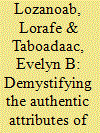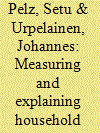|
|
|
Sort Order |
|
|
|
Items / Page
|
|
|
|
|
|
|
| Srl | Item |
| 1 |
ID:
174983


|
|
|
|
|
| Summary/Abstract |
Globally, there is now a substantial decrease in unelectrified households. This unidimensional measure, however, fails to convey the level of electricity access enjoyed by these households, with electricity poverty (EP) still considered prevalent. The multi-faceted nature of EP is already recognised with several multidimensional indices proposed that are still oriented towards the binary approach of either having or not having access to certain attributes. This paper presents the Household Electricity Poverty Matrix (HEPM), a practical tool that assigns tier levels to household electricity access attributes. In this study, EP is measured in three Philippine islands and an aggregated index is compared with that of the Multidimensional Energy Poverty Index (MEPI) approach. Results suggest that Gilutongan and Pangan-an, both having less than 24-h electricity access, experience high EP incidence while Cobrador Island, with 24-h access, has relatively lower EP incidence. MEPI, on the other hand, classifies Gilutongan and Cobrador as having low incidence and Pangan-an as having moderate EP incidence. This work demonstrates that HEPM is a better approach to realistically assess community electrification and can serve as a good basis in enhancing electrical energy policy towards closing the electricity access gap and providing its socio-economic relevance to the target communities.
|
|
|
|
|
|
|
|
|
|
|
|
|
|
|
|
| 2 |
ID:
174989


|
|
|
|
|
| Summary/Abstract |
Household electrification aims to provide populations with access to a wide range of energy services for social and economic development, ranging from lighting to electric cooking. Electrification policy has historically focused on grid connections, however, rather than household capabilities to satisfy energy service needs. We explore a representative panel dataset of households from rural areas of six states across northern India in order to link distinct dimensions of electricity supply with electrical energy service utilisation. Using a regression framework, we show that household electrification policy in India must look beyond connections and consider disaggregate dimensions of supply, paying special attention to supply availability measured in hours per day. Following electrification, households surveyed were highly likely to utilise lighting and ICTs regardless of availability, while an improvement of 12 h was associated with higher likelihoods of space cooling (12.3%-points [CI: 10.7 to 13.9]) and entertainment (13.4%-points [11.2 to 15.6]) services utilisation. In contrast, mechanical loads, thermal loads, refrigeration and electric cooking remain constrained by household wealth and other factors. Disaggregate supply analysis supports the shift towards electrification policy that unlocks desired capabilities while using all available technologies, both grid and off-grid, to achieve more just outcomes for all.
|
|
|
|
|
|
|
|
|
|
|
|
|
|
|
|
| 3 |
ID:
188544


|
|
|
|
|
| Summary/Abstract |
Mini-grids play a critical role in providing electricity to remote, off-grid communities in Sub-Saharan Africa. However, success of mini-grid projects can be hindered by poor cash flows and limited revenue returns. A clear understanding of off-grid households’ preferences for electricity services is a prerequisite for mini-grid stakeholders to set tariff structures and stimulate income-generating power demand to scale up mini-grid deployment. This study conducted a choice experiment survey in two off-grid villages targeted by new mini-grid projects in Tanzania to reveal heterogeneity in households’ preferences for multiple electricity service attributes. We found that households’ heterogeneous preferences were significantly associated with demographic (e.g. gender), socioeconomic (e.g. ownership of TV), and energy-related behavioural characteristics (e.g. charging devices away from home). We suggest that service-based, tiered tariffs and business models can be designed to cater for the heterogenous demands and preferences of different segments of customers. Successful deployment of mini-grids needs to consider the competition from the existing solar home systems and focus on the provision of higher tiers of electricity services. Gender equality issues should be addressed in rural electrification efforts given the significantly greater vulnerability of female-led households to higher electricity fees.
|
|
|
|
|
|
|
|
|
|
|
|
|
|
|
|
|
|
|
|
|